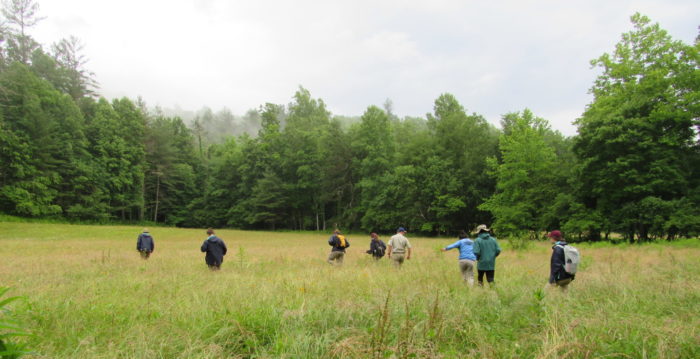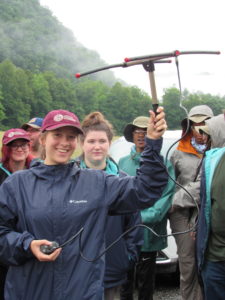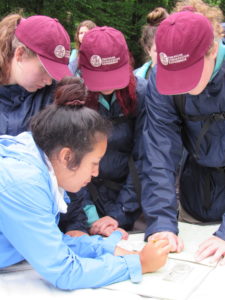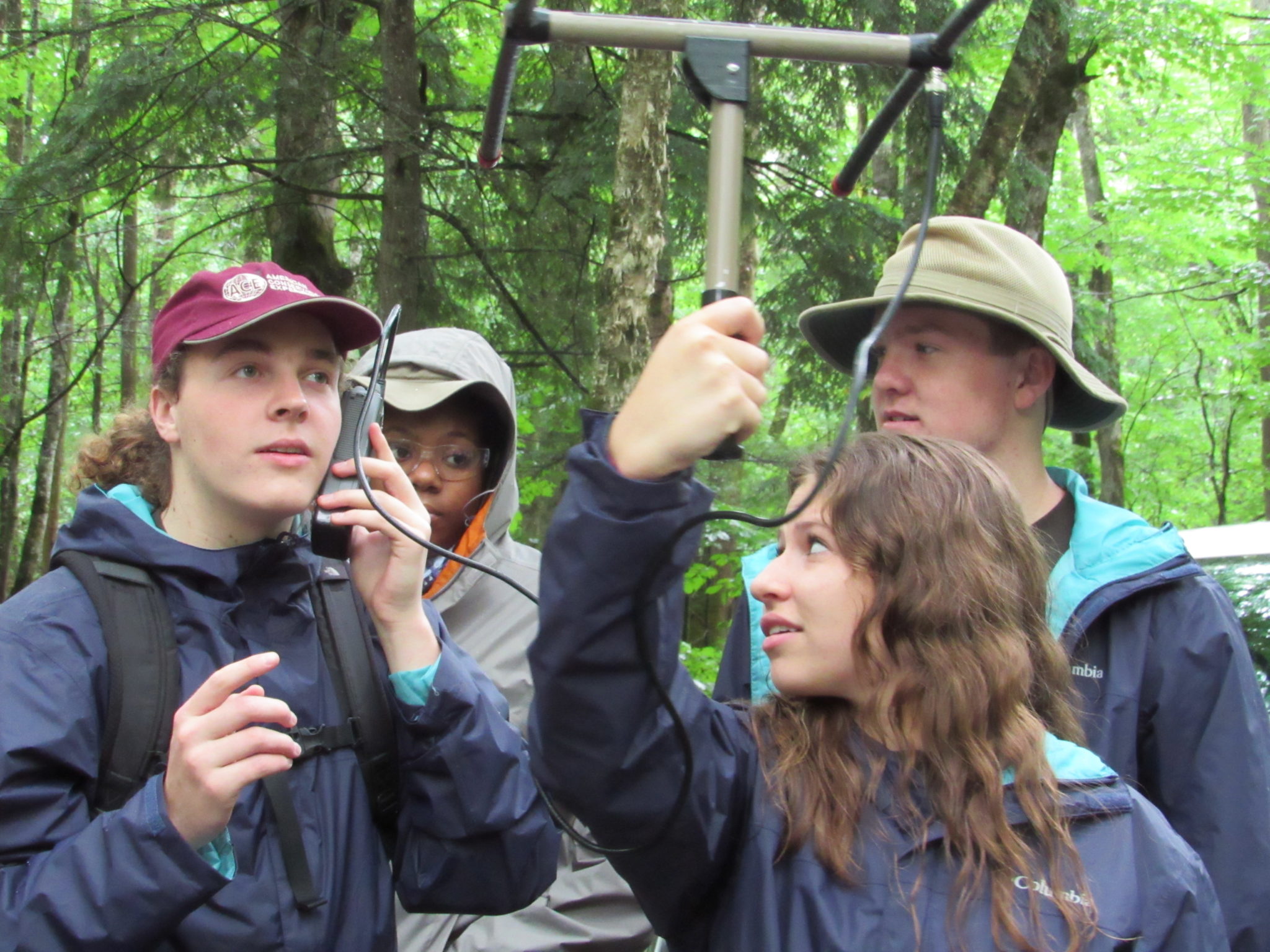GSMNP high school summer intern Adam Wampler describes his favorite day of this six-week internship — learning to locate elk in Cataloochee Valley. Wampler was one of 16 interns who participated in the program.
by Adam Wampler
Tuscola High School
Maggie Valley, North Carolina
“Early mornings” — a phrase that can terrify even the hardiest of workers.
But for the interns rolling toward Cataloochee Valley in the predawn hours, we were not feeling drowsy annoyance or weary acceptance but rather an overall mood of excitement.
A reasonable question one might ask would be, what gave us cause to be excited so early in the morning?
The answer — the promise of adventure. This was our wildlife day.
We were told we were going to meet wildlife biologist Ranger Nick Melton and assist him with whatever he would be doing that day.
We were excited by this news for we had also been told that he, specifically, did a lot of work with elk.
The excitement only grew as we got closer and closer to our designated meeting location in the Cataloochee Valley.
We finally arrived, and our ranks further reinforced with the interns from Asheville Greenworks, who joined us.
Ranger Melton greeted us warmly and told us about our tasks for the day.
Locating the elk calf
First, we were to attempt to collar an elk calf that Ranger Melton had seen the day before.
Second, he was going to teach us to track down a previously collared calf using telemetry.
Finally, he was going to show us specimens and tell us about how he ended up as a ranger and how we might pursue our own career in wildlife management, if we wanted.
First, we went to the field where Ranger Melton had seen the calf the day before.

We patrolled along the edge of the field, keeping our eyes peeled for elk. After a few false alarms, we finally saw an elk cow standing in the old, open-sided barn in the heart of the valley.
Having seen the cow, we now needed to find the calf.
We followed the cow to the edge of the field, where she stopped.
Ranger Melton told us that the fact that she had stopped indicated we were near the calf, and we now needed to proceed into the field to search for the calf.
He gave us a safety talk about what we needed to do to protect ourselves and the elk, and then we set off.
We trekked through the grass that rose, in some areas, as high as our shoulders, trying to find the hiding elk calf. With low voices, we discussed which areas we had not yet checked.
Suddenly the calf sprang from the grass right in front of one of the interns.
We called to Ranger Melton, who was keeping the cow at bay. He came over to us, but the elk cow followed. The calf began running away.
Ranger Melton told us to stay put and let the calf run with the cow following. Because the cow and calf were already running, we were not going to be able to catch the calf without hurting or scaring it. We let them go then headed back to our carpool to go to our next destination.
Learning to use telemetry
We stopped at a pull-off point on the main road, and Ranger Melton showed us some strange looking equipment in his truck that he told us that it would help us with our next task — telemetry.

Telemetry, as we soon learned, consists of using a radio receiver and our hearing ability to track down a transmitter on an elk calf (different calf than before).
We tuned the radio to the correct channel to pick up on the transmitter we wanted, then we proceeded to rotate the antennae in a circle listening for where the beeps from the transmitter were loudest.
“The louder the beep,” Ranger Melton explained, “the closer the antennae is to facing the correct direction.”
We then selected a non-moving object in the direction of the loudest sound. Next, we used a compass to get the bearing of that object.
We then found that same bearing on a map and drew a line at the bearing we found for our inanimate object.
Next, we traveled to a point further down the valley in the general direction of the line we had just drawn. We then repeated that process multiple times in order to create a triangle, within which the transmitter on the elk calf was likely to be found.
After we made a few lines, we started to get the hang of it. It started to get easier, mostly thanks to Ranger Melton allowing us to experiment with the equipment.
We tracked the calf through a field, over a river, and through the woods.

Holding the antennae above our heads, we listened, adjusting the radio receiver in order to help gauge the distance the transmitter was from us. The photo at the top of the page is of me, listening for the “beep” that would indicate the direction of the elk calf.
Finally, we got to the point where we could not adjust the radio receiver anymore, and that was when we saw an elk calf, sitting beneath a fallen tree.
We approached carefully to make sure that it was the elk we were tracking, but our receiver got so loud that the sound scared the calf, which ran off into the woods.
Successful in locating the elk calf, we returned to the ranger station where Ranger Melton showed us some of the specimens that are used for education, such as pelts and hooves of various species of animals.
As we ate lunch, Ranger Melton discussed his education and background and the steps that led to his earning his job.
My favorite day of the internship
This was my favorite day of the summer, partially because it set such a fantastic mood for the entire summer and also because it was both fun and educational.
Throughout the day we learned many things beyond the knowledge we gained in the field. We learned more about each other and more about how one can be involved in the National Park Service, both as an employee and as a volunteer.
My thanks go out to many people — to Ranger Nick Melton for teaching us these skills, to my fellow interns for making this summer something special, and to Ranger Erin Lamm, who organized everything so smoothly.
***
For six weeks during the summer, the high school interns worked with rangers, Teachers in the Parks and volunteers on projects in the park to learn more about GSMNP and to get a feel of what being a park ranger is like.
Sixteen students from North Carolina and Tennessee participated in the program.
Friends of the Smokies has helped support the GSMNP High School Internship Program for 17 years, initially providing the salaries for the interns and then helping fund the program staff salaries. The program is funded in part by the American Conservation Experience (ACE).
This is the ninth guest post written by one of the GSMNP interns about their experiences this past summer. Ranger Erin Lamm took the photos in this post.
A special thanks to Ranger Lamm, who coordinated the North Carolina interns, and Ranger Jessica Snow, who coordinated the Tennessee interns, for their assistance with the interns’ blog posts.
You can support the GSMNP high school summer internship program or support other education programs that FOTS funds, including Teachers in Parks, Parks as Classrooms, the Kathryn McNeill Endowment that funds an education specialist, and the Park Liaison program at the Cherokee School.

